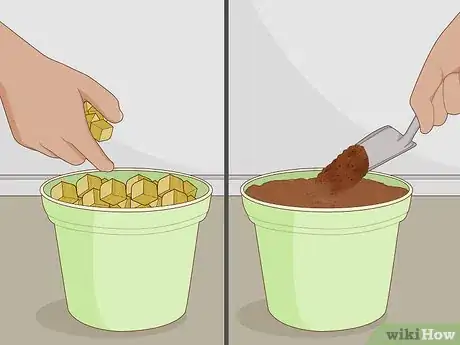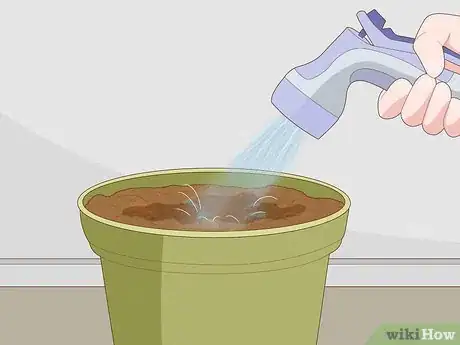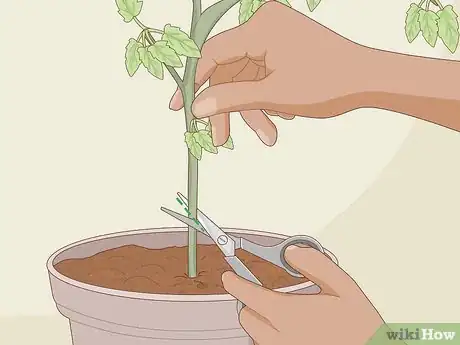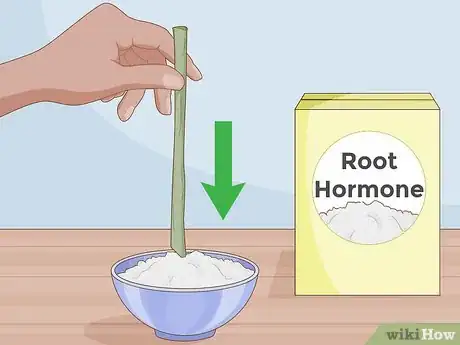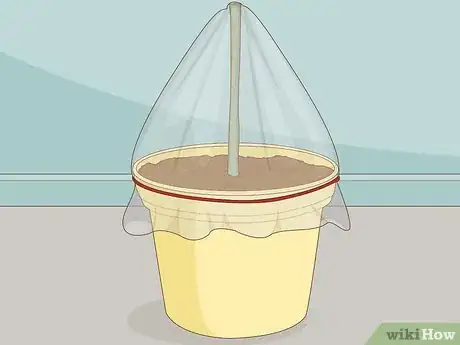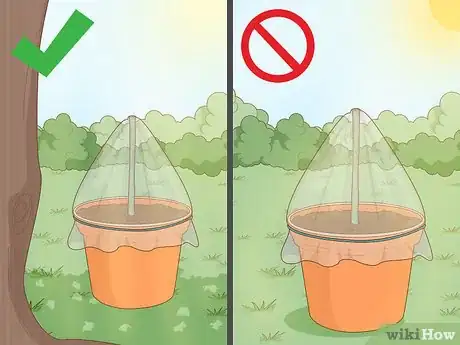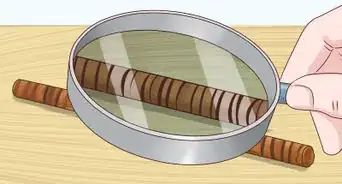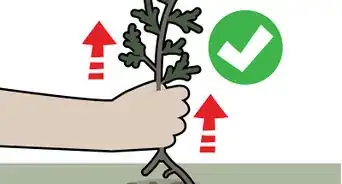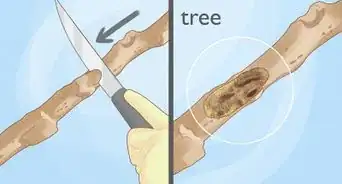This article was co-authored by Andrew Carberry, MPH. Andrew Carberry is a Food Systems Expert and the Senior Program Associate at the Wallace Centere at Winrock International in Little Rock, Arkansas. He has worked in food systems since 2008 and has experience working on farm-to-school projects, food safety programs, and working with local and state coalitions in Arkansas. He is a graduate of the College of William and Mary and holds a Masters degree in public health and nutrition from the University of Tennessee.
wikiHow marks an article as reader-approved once it receives enough positive feedback. This article received 16 testimonials and 88% of readers who voted found it helpful, earning it our reader-approved status.
This article has been viewed 244,230 times.
Plant cloning is a simple process that allows you to replicate a plant by clipping a stem and replanting it. To begin, gather the right container, soil, and root hormones for your plant. Next, you will cut, replant, and cover the plant. Ensure that growing conditions are favorable for your particular plant to help it flourish.
Steps
Gathering The Right Materials
-
1Choose your cloning container. The type of container you choose will depend upon how large the plant will be once it grows and how many plants you’re trying to clone in one container. Do a little research on your plant first to determine how big your container should be.
- Some people prefer to use pots for plant cloning, while others will use something as simple as a plastic cup with holes poked into the bottom.
- A translucent container is usually best so you can see when and where the plant is taking root.
-
2Decide whether you want to clone the plant in rockwool or soil. When you clone plants, you put a piece of a plant into soil or rockwool so that it can take root and grow.
- Rockwool is more complicated and requires more preparation than soil. It’s needs to be soaked overnight in water with a PH balance of 4.5, and it doesn’t contain the same nutrients that natural soil does.[1] You also need to take the time to cut a hole in the center of a rockwool block so that it’s not too big and not too small for the plant you’re cloning.
- Potting soil, seed starting mix, or well composted garden soil can all be used for your plant. Normal soil dug up from your garden may not be ideal.
Advertisement -
3Decide whether or not you want to use a root hormone. Root hormones are used in the cloning process to encourage plant cell growth. Plants naturally contain hormones called auxins, which help plants determine whether or not they should develop more leaves versus more roots. When you purchase a root hormone in a bottle, you’ll be using a synthetic auxin. When the auxin is applied, the plant will think it needs to grow more roots, and the cloning process begins. [2]
- If you’re an organic gardener, root hormones may not be your friend. Many root hormones contain fungicides and chemicals that might not be earth friendly. If you are concerned about the use of chemicals in your gardening, you may want to opt for natural alternatives, such as willow tea, cinnamon, or diluted apple cider vinegar.
- Plants like tomatoes are easily cloned because they produce a lot of natural auxin, but other plants may only put out roots from the original root ball at the tip of the stem — which may make it difficult to get the plant to root without a synthetic hormone.[3] Do some research on your plant before making any decisions to see what’s right for the situation.
- Never dip your plant matter into your container of hormone. Take out the amount of hormone you need and apply to the plant per the instructions included. This is to avoid contaminating your supply.
Planting The Stem
-
1Fill the pot or container with soil or rockwool.
- If you’ve chosen to use soil, fill the container to the top. Poke a hole through the center, all the way down to the bottom of the container.
- If you’ve chosen to use rockwool, you can simply insert the chunk of rockwool into the container.
-
2Water the soil. Pour enough water into the soil that it’s wet, but not drenched. If you’re using rockwool, it would already have been soaked overnight, so adding more water is not necessary.
-
3Make a diagonal cut on the stem of the plant using a sharp knife or scissors. You’ll want to select a lateral stem to cut, not a terminal stem. Terminal stems are the main stems that come up from the ground, while lateral stems protrude from the sides of the terminal stems. [4]
- After you’ve made your cut, look at the stem and remove any leaves or flower buds from its base. When there are too many leaves or buds on a plant cutting, they suck most of the water from the base of the stem and may keep your plant from rooting. [5]
-
4Dip the stem in root hormone (if you've that decided root hormones are right for your plant). Root hormones can be in liquid or powder form. If you’re using a powder, dip the stem in some water and then apply the powder to the end, so it sticks. Do not coat the whole stem in root hormone. Focus on lightly coating the very bottom of the stem.
-
5Put the stem of the plant into the hole in the soil or rockwool. Try to put about one-third of the stem into the hole.[6] .
-
6Cover the container in plastic or glass. A plastic bag can often work well for this if you have nothing else. When you cover the plant, it keeps the moisture and allows the plant to continue living while it attempts to produce roots. [7] What you use to cover the plant will depend upon the container you’ve chosen to house your clone.
Letting it Grow
-
1Keep the container in a warm area where it can get SOME sunlight. If you put the plant in a place where it gets direct sunlight all day, that may put too much stress on the cutting and kill it.[8]
-
2Add a little water to the soil every day, keeping the soil moist (but not drenched) while it begins to root. After about a week or two, your plant should begin to form roots. Hooray! Clonage achieved.
Expert Q&A
Did you know you can get expert answers for this article?
Unlock expert answers by supporting wikiHow
-
QuestionWhat is the minimum age that mother plant should be before cloning?
 Andrew Carberry, MPHAndrew Carberry is a Food Systems Expert and the Senior Program Associate at the Wallace Centere at Winrock International in Little Rock, Arkansas. He has worked in food systems since 2008 and has experience working on farm-to-school projects, food safety programs, and working with local and state coalitions in Arkansas. He is a graduate of the College of William and Mary and holds a Masters degree in public health and nutrition from the University of Tennessee.
Andrew Carberry, MPHAndrew Carberry is a Food Systems Expert and the Senior Program Associate at the Wallace Centere at Winrock International in Little Rock, Arkansas. He has worked in food systems since 2008 and has experience working on farm-to-school projects, food safety programs, and working with local and state coalitions in Arkansas. He is a graduate of the College of William and Mary and holds a Masters degree in public health and nutrition from the University of Tennessee.
Food Systems Expert
-
QuestionDo you leave plastic on top while the plant is in the sun?
 Andrew Carberry, MPHAndrew Carberry is a Food Systems Expert and the Senior Program Associate at the Wallace Centere at Winrock International in Little Rock, Arkansas. He has worked in food systems since 2008 and has experience working on farm-to-school projects, food safety programs, and working with local and state coalitions in Arkansas. He is a graduate of the College of William and Mary and holds a Masters degree in public health and nutrition from the University of Tennessee.
Andrew Carberry, MPHAndrew Carberry is a Food Systems Expert and the Senior Program Associate at the Wallace Centere at Winrock International in Little Rock, Arkansas. He has worked in food systems since 2008 and has experience working on farm-to-school projects, food safety programs, and working with local and state coalitions in Arkansas. He is a graduate of the College of William and Mary and holds a Masters degree in public health and nutrition from the University of Tennessee.
Food Systems Expert
-
QuestionHow much root hormone do I need to clone a plant?
 Community AnswerYou only need enough to cover the exposed area at the bottom of the stem, right where you cut it.
Community AnswerYou only need enough to cover the exposed area at the bottom of the stem, right where you cut it.
Things You'll Need
- Scissors or a sharp knife
- Rockwool or soil
- Clean pot or container
- Root hormone
- Water
References
- ↑ https://suagcertify.com/wp-content/uploads/2020/10/Rockwood-Cubes-Fact-Sheet-1-2.pdf
- ↑ https://www.youtube.com/watch?v=EZ5tU45Ti_g
- ↑ http://arstechnica.com/science/2013/04/how-to-create-near-infinite-clones-of-your-favorite-tomato-or-any-plant/
- ↑ https://gardening.tips.net/T007368_What_are_Cuttings.html
- ↑ http://arstechnica.com/science/2013/04/how-to-create-near-infinite-clones-of-your-favorite-tomato-or-any-plant/
- ↑ https://www.teachervision.com/plant-reproduction/lesson-plan/63847.html
- ↑ http://arstechnica.com/science/2013/04/how-to-create-near-infinite-clones-of-your-favorite-tomato-or-any-plant/
- ↑ https://www.teachervision.com/plant-reproduction/lesson-plan/63847.html
- ↑ https://www.youtube.com/watch?v=WnwZqcgLcDI
About This Article
If you want to clone a plant, start by filling a pot with soil and poking a hole in the soil all the way to the bottom. Then, select one of the plant's lateral stems, which are the stems protruding from the side of the main stem, and cut it diagonally. Dip the end of your stem into root hormone, then put the stem in the hole you made in your soil. If you don't have a cover for the pot, use a plastic bag to cover the stem so it can stay alive while trying to produce roots. To give your plant the best chance to form roots, water it daily and place it where it will get some sunlight. To learn more from our Food Systems Expert co-author, like what planting mediums work best for cloning a plant, keep reading!



